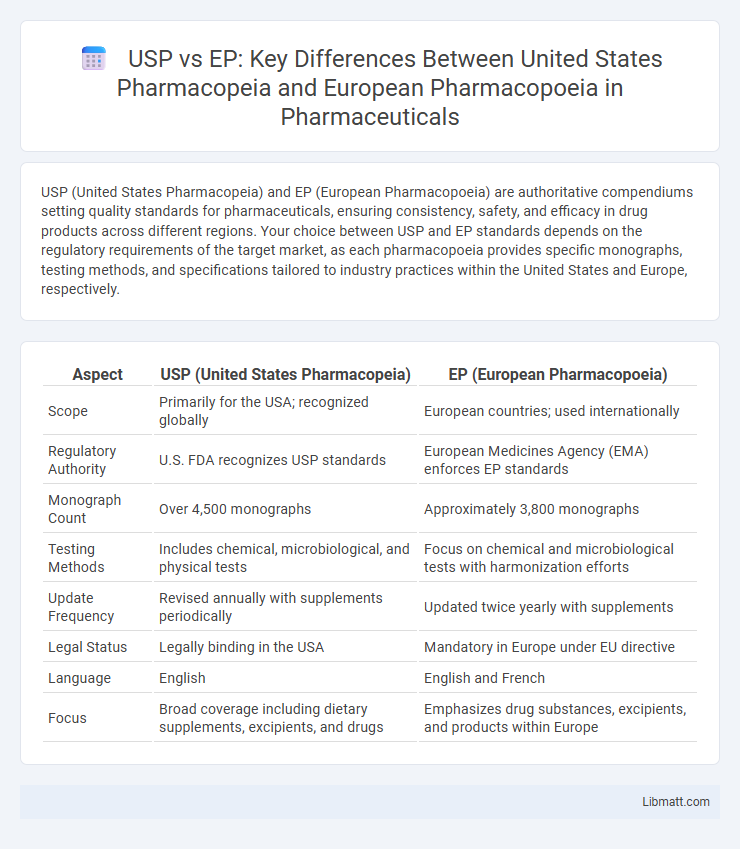USP (United States Pharmacopeia) and EP (European Pharmacopoeia) are authoritative compendiums setting quality standards for pharmaceuticals, ensuring consistency, safety, and efficacy in drug products across different regions. Your choice between USP and EP standards depends on the regulatory requirements of the target market, as each pharmacopoeia provides specific monographs, testing methods, and specifications tailored to industry practices within the United States and Europe, respectively.
Table of Comparison
| Aspect | USP (United States Pharmacopeia) | EP (European Pharmacopoeia) |
|---|---|---|
| Scope | Primarily for the USA; recognized globally | European countries; used internationally |
| Regulatory Authority | U.S. FDA recognizes USP standards | European Medicines Agency (EMA) enforces EP standards |
| Monograph Count | Over 4,500 monographs | Approximately 3,800 monographs |
| Testing Methods | Includes chemical, microbiological, and physical tests | Focus on chemical and microbiological tests with harmonization efforts |
| Update Frequency | Revised annually with supplements periodically | Updated twice yearly with supplements |
| Legal Status | Legally binding in the USA | Mandatory in Europe under EU directive |
| Language | English | English and French |
| Focus | Broad coverage including dietary supplements, excipients, and drugs | Emphasizes drug substances, excipients, and products within Europe |
Introduction to USP and EP
The United States Pharmacopeia (USP) and the European Pharmacopoeia (EP) are authoritative compendiums setting global standards for the quality, purity, and strength of medicines and food ingredients. USP, established in 1820, serves primarily the U.S. market but influences international pharmaceutical practices, while EP, initiated in 1964 by the Council of Europe, caters to European countries with harmonized pharmaceutical standards. Both compendia provide monographs, general chapters, and reference standards vital for regulatory compliance and ensuring public health safety.
Overview of Pharmaceutical Standards
USP (United States Pharmacopeia) and EP (European Pharmacopoeia) are authoritative compendiums that establish quality standards for pharmaceuticals, ensuring the safety, efficacy, and consistency of medications. USP standards are primarily used in the United States, while EP standards serve the European Union and other countries adopting its guidelines. Your compliance with these pharmacopeial standards is crucial for market approval and maintaining drug quality worldwide.
Key Differences Between USP and EP
USP (United States Pharmacopeia) and EP (European Pharmacopoeia) differ primarily in their regional scope, with USP serving the United States and EP covering Europe. USP standards emphasize monographs and tests relevant to U.S. regulatory requirements, while EP provides harmonized guidelines aligned with the European Medicines Agency. Variations also exist in testing methodologies, reference materials, and acceptance criteria, reflecting differing regulatory frameworks and market needs.
Harmonization Efforts and Challenges
Harmonization efforts between the United States Pharmacopeia (USP) and European Pharmacopeia (EP) aim to establish common quality standards for pharmaceuticals, ensuring consistency in drug safety and efficacy across global markets. Key challenges include differences in regional regulatory requirements, variations in testing methodologies, and divergent monograph specifications that complicate full alignment. Understanding these complexities helps you navigate compliance and facilitates smoother international pharmaceutical approvals.
Quality Control and Compliance
USP and EP set distinct standards for pharmaceutical quality control and compliance, with USP primarily used in the United States and EP in Europe. Both Pharmacopeias establish rigorous testing methods, specifications, and purity criteria to ensure the safety and efficacy of medicines. Compliance with USP or EP standards is mandatory for manufacturers seeking market authorization, influencing batch release decisions and regulatory inspections.
Testing Methods and Specifications
USP and EP establish distinct testing methods and specifications tailored for pharmaceutical quality control, with USP often emphasizing moisture content and dissolution testing, while EP prioritizes potency assays and microbial limits. Both pharmacopeias define stringent criteria for identity, purity, and strength, yet testing procedures may vary based on regional regulations and product types. Understanding these differences ensures your pharmaceutical products meet global compliance standards effectively.
Regulatory Requirements for USP and EP
The United States Pharmacopeia (USP) and European Pharmacopoeia (EP) establish regulatory standards that ensure the quality, safety, and efficacy of pharmaceuticals within their respective jurisdictions. USP standards are mandatory for medications marketed in the United States and are enforced by the FDA, requiring compliance with specific monographs, tests, and assays. EP standards apply across the European Union and other member states, enforced by relevant national regulatory authorities, focusing on harmonized quality specifications to facilitate mutual recognition and market access.
Impact on Pharmaceutical Manufacturing
USP and EP standards significantly influence pharmaceutical manufacturing by setting stringent quality, safety, and purity benchmarks for raw materials and finished products. These compendia guide Your manufacturing processes through detailed monographs, analytical methods, and validation protocols, ensuring compliance with regulatory authorities worldwide. Adherence to both USP and EP helps mitigate risks, maintain product consistency, and facilitate global market access.
Selecting the Right Standard for Your Product
Choosing between USP (United States Pharmacopeia) and EP (European Pharmacopoeia) depends on your product's target market and regulatory requirements. USP standards are mandatory for pharmaceuticals marketed in the United States, while EP is required for products distributed within the European Union. Aligning your product with the appropriate pharmacopeial standards ensures compliance, quality, and acceptance in the relevant regulatory landscape.
Future Trends in Pharmacopeial Standards
Pharmacopeial standards like USP and EP are evolving rapidly to incorporate advanced analytical techniques such as high-resolution mass spectrometry and biologics characterization. Regulatory bodies emphasize harmonization and real-time data integration to enhance drug quality and patient safety globally. Your pharmaceutical practices must adapt to these future trends to ensure compliance and innovation in product development.
USP vs EP Infographic

 libmatt.com
libmatt.com